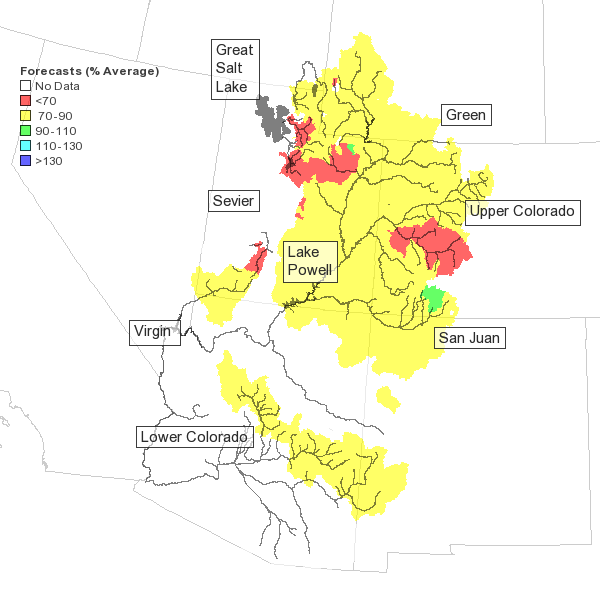Well that was fun while it lasted, eh? Looks like it’s back to draining reservoirs on the Colorado!
2011, a big sloppy wet kiss of a water year, pumped up total storage in the reservoirs behind Glen Canyon and Hoover dams by some 5 million acre feet. But the first forecast of the year suggests a turn back in the opposite direction.
The largest single water user on the Colorado River, the Imperial Irrigation District in southeast California, diverted 2.9 million acre feet from the river at Imperial Dam in 2011. Arizona’s entire consumptive use was 2.7 million acre feet.* Scale matters here, and I use those numbers to give some sense of the meaning of a 2.6 million acre drop in forecast Colorado River flows in 2012.
That 2.6 million acre foot drop is the headline number that came out of this week’s release of the first forecasts from the Colorado Basin River Forecast Center. The forecast calls for flows into Lake Powell, which captures the bulk of the Colorado’s supply, of 71 percent of the mean during the key April-July time period, which is when most of the snowmelt arrives. We’re talking here about paper water, estimates codified in the monthly planning documents prepared by the US Bureau of Reclamation for the management of the water under its stewardship. But on paper, when the next Bureau monthly report comes out next week, the anticipated balance sheet for the year will be down 2.6 maf from what the December report showed. The 2.6 maf represents the difference between a projection made back in October, when we had essentially zero information to go on, and the first preliminary forecast based on actual snow falling (or not falling) on actual mountains.
We’ll have some clearer numbers next week when the Bureau takes the new CBRFC numbers and plugs them into its water management model, but during a conference call Friday to discuss the forecast, one of the Bureau officials on the line uttered the 2.6 maf number, which is the difference in Lake Powell inflows this year under the new forecast as compared to the October projections.
* Source: USBR provisional water use report, 2011 (pdf)


Pingback: Water forecasts for Colorado River system are sharply down | Politics in the Zeros
Pingback: California drought continues, could be driest year on record